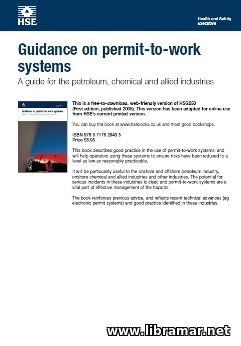 The present book was released to provide all people working in the chemical, petroleum and all relevant areas with the clear and easily understandable descriptions of the established good practices related to the use of the PTW, i.e. permit to work systems. The authors have also intended to assist the operators who are using such systems so that they can ensure that the associated risks have all been reduced to the acceptable and reasonable limits.
The publication is expected to be particularly appreciated by the workers of the petroleum industry, working on both onshore fields and offshore installations. We clearly understand and realize the potential for the serious and hazardous incidents in the petroleum and chemical industries, and that is why the implementation of the PTW system is considered an integral part of the safety development systems.
The booklet duly reflects all important technological advances in the field, such as the implementation of the EPS, standing for the electronic permit systems and others. The volume will provide interested readers with the information about the basics of PTW systems, responsibilities of all parties involved, associated training and competence of the personnel, risk assessment, planning of the working activities etc.
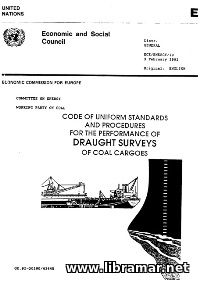 Draught survey is a common method widely used for determining the weight of the bulk cargo transported by sea, and particularly coal cargo. The accuracy provided by these surveys vary. There may be some discrepancies between the loading and discharge results that lead to the commercial disputes between the parties involved including ship operators, sellers, buyers, marine surveyors etc., because the weight of the cargo is considered a basis for calculating the payment, port fees and freight.
Taking into account increasing value and volume of the coal trade, the shippers and receivers of the cargo are becoming seriously concerned about these discrepancies. That is why there was a need for the procedures and standards to be followed during the draught surveys.
The present Code contains the full set of recommendations to be used when conducting draught surveys and is expected to benefit absolutely all parties; it is also intended to provide valuable contribution to the implementation of the internationally recognized trade practices. It's main purpose is to make the above mentioned procedures uniform and give practical reference to the draught surveyors who may follow its provisions.
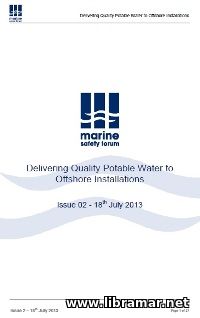 The potable water including that delivered to the offshore installations shall always be "wholesome", i.e. fully compliant with the defined standards and national regulations. Subject standards are commonly developed in order to protect human health and the definition of term "wholesome" is intended to reflect the significance of the ensuring that the drinking water is of the quality acceptable to its consumers.
The provisions of the present document are aimed to apply mainly to the vessels that operate in the UK Continental Shelf; however it may also be applied to the vessels operating in other regions. The publication prepared by the specialists of the MSF, standing for the Marine Safety Forum, will give practical guidance relating to the delivery of the drinking water to the offshore facilities. Note that it is not intended to cover the maintenance of the hoses used offshore. The volume opens with the concise glossary of terminology followed by the background information.
A brief overview is provided of the supply chain of pot water to offshore facilities covering the potential areas of water contamination. Where such risk exists, control measures is necessary in order to minimize it. Two sections of the publication have been structured to reflect the steps required to be taken. These measures would normally include management and maintenance as well as the treatment and monitoring...
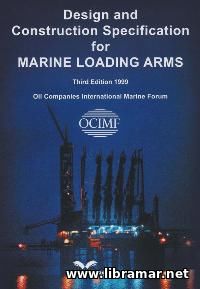 The present publication was prepared and officially published by the OCIMF organization. The loading arms are ordered to be used for specific practical applications that required thorough and very accurate specifications as well as considerable assessment by the engineers. That is the reason why they should not be treated only as pre-fabricated hardware.
The document will provide the shipping industry with the minimum basic requirements applicable to the marine loading arms together with the ancillary equipment commonly used for the loading and discharge of the vessels and barges at the marine terminals arranged in conventional manner. Opening with the information the standards and practices generally applied to the design and construction, the content of the volume proceeds to the design details and technical requirements and materials.
The chapter dealing with the design covers the general information and stress analysis. The other sections address the swivels, structural bearings, ERS, standing for the emergency release systems, quick connect and disconnect couplers, hydraulic power system and electrical components, controls and accessories, testing and control of quality, recommended documentation and other important matters.
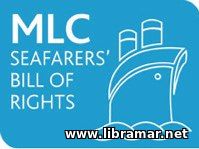 The document was published by the ITF, i.e. International Transport Workers' Federation to provide required guidance to the ILO MLC, 2006. The content of the publication starts with the list of abbreviations and terms. You will first read about when and why the MLC was adopted and who is covered under the provisions of this convention; moreover, this section also covers the basic and worker's rights together with the rights of the seafarers, structure of the convention and substantial equivalence.
The second section is devoted to the rights under the MLC and addresses the minimal requirements applicable to the seafarers working on board ships, conditions of employment, accommodation and recreational facilities as well as catering and food, health protection and medical care, social security and welfare, actually everything what is covered by the convention itself.
The next chapter is dealing with the compliance and enforcement including responsibilities of the Flag States, declaration of compliance, certification and their validity, maritime casualties, inspections conducted in ports and many other aspects. The last two sections of the document contain list of conventions that have been incorporated into the Maritime Labor Convention, and MLC index.
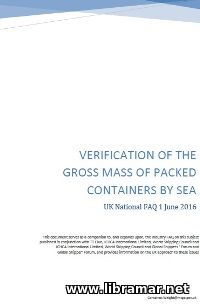 The present official publication was prepared and released to serve as a good companion to the industry FAQ document on the subject of verification of the gross mass of the packed containers transported on board ships, and expands the content of the original publication. It was developed on the basis of the joint efforts of the leading industry experts representing different organizations such as the WSC, standing for the World Shipping Council, Global Shippers Forum, TT Club and others.
There are three major sections making the main body of the document. The section A is covering the requirement for the accurate gross mass, application of the enforcement tolerance threshold to the determination of compliance with relevant requirements of SOLAS convention, i.e. the content of the industry FAQs A6, A9, A10 and A12. The section B addresses the industry FAQs nos. B1, B3, B4 including list of the wieghbridges available publically, verified weighers and container handling equipment accuracy.
The section C is devoted to the Method 2 implemented by UK MCA. Three appendices at the end of the document cover testing and examination of the AWI, i.e. automated weighing instruments used for the verification of the gross mass, weighbridges and requirements to the weighing equipment.
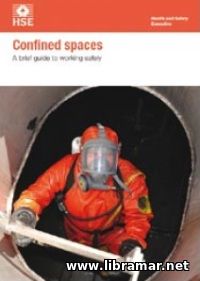 This compact leaflet was released by HSE Executive to explain to the readers what they may need to do as the employers to protect their employees while they are working in enclosed, or confined, spaced. Note that the booklet will also be found useful by the self-employed people. The original intention of the authors was to provide industry with the description of the actions that are necessary to be taken in order to meet all applicable requirements of the Control Spaces Regulations.
Unfortunately there are so many people injured and even killer in the enclosed areas each ear. This is sad truth in many industries including shipping industry. And the people who were killed were not only people who were actually working but also ones trying to rescue them. The confined spaces include any enclosed spaces where a serious risk to human life and health is presented due to the presence of various dangerous conditions and/or hazardous substances.
Some of the enclosed spaces are very easy to identify, for example spaces with limited number and size of the openings, however others may be not obvious at all but they are equally dangerous, these would typically include ductwork, vasts, poorly ventilated spaces, combustion chambers etc.
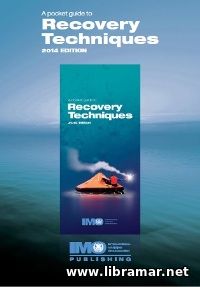 This is the official IMO released publication providing seafarers with the required guidance relating to the recovery techniques. Recovery of the people from water is one of the things that seafarers may encounter while working on board ships. This may be someone overboard from their vessel, such as a crew member or passenger, or their vessel may be responding to the emergency signal received from another ship.
In many regions, particularly when out of range of the SAR, i.e. search and rescue, facilities based ashore, your vessel may actually be the only rescue unit available, or the first one to be there in time. Most of the vessels are required to have plans and procedures covering the recovery of people from water, and the plans shall be ship-specific. You capability will become a matter of highest importance would you be required to participate in any recovery operation.
It means that every person engaged in such activities shall be aware of the above mentioned procedures and plans and be prepared to follow them. The process of recovery is not easy and may actually be even more complicated by the size of the vessel, physical capabilities of people to be recovered, movement between the ships and craft alongside, and other aspects all of which shall be taken into consideration...
« 1 2 ... 8 9 10 11 12 ... 24 25 » |







